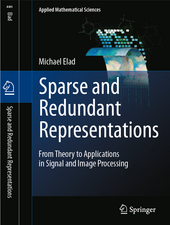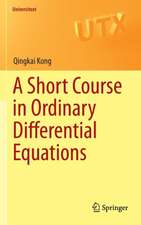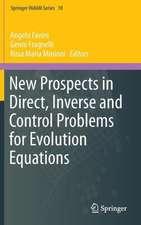Differential Equations: Theory and Applications
Autor David Betounesen Limba Engleză Paperback – 28 noi 2014
| Toate formatele și edițiile | Preț | Express |
|---|---|---|
| Paperback (1) | 474.38 lei 6-8 săpt. | |
| Springer – 28 noi 2014 | 474.38 lei 6-8 săpt. | |
| Hardback (1) | 607.33 lei 6-8 săpt. | |
| Springer – 16 noi 2009 | 607.33 lei 6-8 săpt. |
Preț: 474.38 lei
Nou
Puncte Express: 712
Preț estimativ în valută:
90.78€ • 97.07$ • 75.68£
90.78€ • 97.07$ • 75.68£
Carte tipărită la comandă
Livrare economică 18 aprilie-02 mai
Preluare comenzi: 021 569.72.76
Specificații
ISBN-13: 9781489982650
ISBN-10: 1489982655
Pagini: 640
Ilustrații: XIV, 626 p.
Dimensiuni: 155 x 235 x 34 mm
Greutate: 0.89 kg
Ediția:2nd ed. 2010
Editura: Springer
Colecția Springer
Locul publicării:New York, NY, United States
ISBN-10: 1489982655
Pagini: 640
Ilustrații: XIV, 626 p.
Dimensiuni: 155 x 235 x 34 mm
Greutate: 0.89 kg
Ediția:2nd ed. 2010
Editura: Springer
Colecția Springer
Locul publicării:New York, NY, United States
Public țintă
GraduateCuprins
Techniques, Concepts and Examples.- Existence and Uniqueness: The Flow Map.- Linear Systems.- Linearization #x0026; Transformation.- Stability Theory.- Integrable Systems.- Newtonian Mechanics.- Hamiltonian Systems.- Elementary Analysis.- Lipschitz Maps and Linearization.- Linear Algebra.- Electronic Contents.
Recenzii
From the reviews:
"This book is a comprehensive reader-friendly introduction to differential equations. … The theory is illustrated by a great number of nice examples, applications, figures. … I can warmly recommend the book for graduate mathematics, physic students and also students in applied sciences. Finally, I would like to encourage students, their professors and researchers to do computer experiments … for improving their study, teaching and scientific work." (János Karsai, Acta Scientiarum Mathematica, Vol. 70, 2004)
"The book under review is intended for a one or two semester graduate course in ordinary differential equations. A novel feature of the book is the incorporation of Maple into the presentation … . This well written book offers an application-minded instructor great flexibility in designing a course. All the necessary theory is included, as well as wide range of examples from physics and engineering … ." (J. E. Paullet, Zeitschrift für Angewandte Mathematik und Mechanik, Vol. 84 (6), 2004)
"This book is one of the few graduate differential equations texts that use the computer to enhance the concepts and theory normally taught to first- and second-year graduate students in mathematics. The author gives a comprehensive introduction to the theory of ordinary differential equations with a focus on mechanics and dynamical systems … ." (Wei Nian Zhang, Mathematical Reviews, 2002 b)
"This book is intended to serve as a comprehensive introduction to the theory of ordinary differential equations … . the material is organized so that it can be also used in a wider setting within today’s modern university and society. … The book makes every attempt to blend together the traditional theoretical material on differential equations and the new techniques afforded by computer algebra systems … ." (International Aerospace Abstracts, Vol. 42 (5), 2002)
"This book is intended for first- and second-year graduate students in mathematics and also organized to be used for interdisciplinary courses in applied mathematics, physics, and engineering. … The book is well written and provides many interesting examples. The author gives a comprehensive introduction to the theory on ordinary differential equations with a focus on mechanics and dynamical systems. The exposition is clear and easily understood." (Yuan Rong, Zentralblatt MATH, Vol. 993 (18), 2002)
From the reviews of the second edition:
“This textbook is intended as a comprehensive introduction to ordinary differential equations for graduate students. … This is a very readable text that is enhanced with good supporting figures. Especially striking are hand-drawn figures reproduced to look like blackboard sketches. The proofs throughout the book are particularly … detailed. There are also well-designed exercises for every section in the text. This is one graduate-level graduate differential equations text that really would support self-study.” (William J. Satzer, The Mathematical Association of America, February, 2010)
“The book is an introduction to the theory of ordinary differential equations and intended for first- or second-year graduate students. … The main feature of this book is its comprehensive structure, many examples and illustrations, and complementary electronic material. The electronic material is now provided on the Springer’ website and consists of about 40 Maple-worksheets.” (Sergiy Yanchuk, Zentralblatt MATH, Vol. 1192, 2010)
“This is the updated edition of a comprehensive introduction to ordinary differential equations from the view point of dynamical systems. … The book is written in a concise style suitable for advanced undergraduate and beginning graduate students. … all chapters including the online materials have been revised and enhanced. Moreover, many new examples and exercises have been added.” (G. Teschl, Monatshefte für Mathematik, Vol. 162 (3), March, 2011)
“This is quite a good … intermediate level textbook on ordinary differential equations. It emphasizes dynamical systems and mechanics, nicely illustrating geometric ideas with good graphics … . this textbook has lots to recommend it.” (Robert E. O’Malley, Jr., SIAM Review, Vol. 52 (2), 2010)
"This book is a comprehensive reader-friendly introduction to differential equations. … The theory is illustrated by a great number of nice examples, applications, figures. … I can warmly recommend the book for graduate mathematics, physic students and also students in applied sciences. Finally, I would like to encourage students, their professors and researchers to do computer experiments … for improving their study, teaching and scientific work." (János Karsai, Acta Scientiarum Mathematica, Vol. 70, 2004)
"The book under review is intended for a one or two semester graduate course in ordinary differential equations. A novel feature of the book is the incorporation of Maple into the presentation … . This well written book offers an application-minded instructor great flexibility in designing a course. All the necessary theory is included, as well as wide range of examples from physics and engineering … ." (J. E. Paullet, Zeitschrift für Angewandte Mathematik und Mechanik, Vol. 84 (6), 2004)
"This book is one of the few graduate differential equations texts that use the computer to enhance the concepts and theory normally taught to first- and second-year graduate students in mathematics. The author gives a comprehensive introduction to the theory of ordinary differential equations with a focus on mechanics and dynamical systems … ." (Wei Nian Zhang, Mathematical Reviews, 2002 b)
"This book is intended to serve as a comprehensive introduction to the theory of ordinary differential equations … . the material is organized so that it can be also used in a wider setting within today’s modern university and society. … The book makes every attempt to blend together the traditional theoretical material on differential equations and the new techniques afforded by computer algebra systems … ." (International Aerospace Abstracts, Vol. 42 (5), 2002)
"This book is intended for first- and second-year graduate students in mathematics and also organized to be used for interdisciplinary courses in applied mathematics, physics, and engineering. … The book is well written and provides many interesting examples. The author gives a comprehensive introduction to the theory on ordinary differential equations with a focus on mechanics and dynamical systems. The exposition is clear and easily understood." (Yuan Rong, Zentralblatt MATH, Vol. 993 (18), 2002)
From the reviews of the second edition:
“This textbook is intended as a comprehensive introduction to ordinary differential equations for graduate students. … This is a very readable text that is enhanced with good supporting figures. Especially striking are hand-drawn figures reproduced to look like blackboard sketches. The proofs throughout the book are particularly … detailed. There are also well-designed exercises for every section in the text. This is one graduate-level graduate differential equations text that really would support self-study.” (William J. Satzer, The Mathematical Association of America, February, 2010)
“The book is an introduction to the theory of ordinary differential equations and intended for first- or second-year graduate students. … The main feature of this book is its comprehensive structure, many examples and illustrations, and complementary electronic material. The electronic material is now provided on the Springer’ website and consists of about 40 Maple-worksheets.” (Sergiy Yanchuk, Zentralblatt MATH, Vol. 1192, 2010)
“This is the updated edition of a comprehensive introduction to ordinary differential equations from the view point of dynamical systems. … The book is written in a concise style suitable for advanced undergraduate and beginning graduate students. … all chapters including the online materials have been revised and enhanced. Moreover, many new examples and exercises have been added.” (G. Teschl, Monatshefte für Mathematik, Vol. 162 (3), March, 2011)
“This is quite a good … intermediate level textbook on ordinary differential equations. It emphasizes dynamical systems and mechanics, nicely illustrating geometric ideas with good graphics … . this textbook has lots to recommend it.” (Robert E. O’Malley, Jr., SIAM Review, Vol. 52 (2), 2010)
Textul de pe ultima copertă
The book provides a comprehensive introduction to the theory of ordinary differential equations at the graduate level and includes applications to Newtonian and Hamiltonian mechanics. It not only has a large number of examples and computer graphics, but also has a complete collection of proofs for the major theorems, ranging from the usual existence and uniqueness results to the Hartman-Grobman linearization theorem and the Jordan canonical form theorem.
The book can be used almost exclusively in the traditional way for graduate math courses, or it can be used in an applied way for interdisciplinary courses involving physics, engineering, and other science majors. For this reason an extensive computer component using Maple is provided on Springer’s website.
This new edition has been extensively revised throughout, particularly the chapters on linear systems, stability theory and Hamiltonian systems.
The computer component is an in-depth supplement and complementto the material in the text and contains an introduction to discrete dynamical systems and iterated maps, special-purpose Maple code for animating phase portraits, stair diagrams, N-body motions, and rigid-body motions, and numerous tutorial Maple worksheets pertaining to all aspects of using Maple to study the topics in the text.
Review from first edition:
"This book is intended for first- and second- year graduate students in mathematics and also organized to be used for interdisciplinary courses in applied mathematics, physics, and engineering. ... The book is well written and provides many interesting examples. The author gives a comprehensive introduction to the theory on ordinary differential equations with a focus on mechanics and dynamical systems. The exposition is clear and easily understood...." (Yuan Rong, Zentralblatt MATH, Vol. 993 (18), 2002)
The book can be used almost exclusively in the traditional way for graduate math courses, or it can be used in an applied way for interdisciplinary courses involving physics, engineering, and other science majors. For this reason an extensive computer component using Maple is provided on Springer’s website.
This new edition has been extensively revised throughout, particularly the chapters on linear systems, stability theory and Hamiltonian systems.
The computer component is an in-depth supplement and complementto the material in the text and contains an introduction to discrete dynamical systems and iterated maps, special-purpose Maple code for animating phase portraits, stair diagrams, N-body motions, and rigid-body motions, and numerous tutorial Maple worksheets pertaining to all aspects of using Maple to study the topics in the text.
Review from first edition:
"This book is intended for first- and second- year graduate students in mathematics and also organized to be used for interdisciplinary courses in applied mathematics, physics, and engineering. ... The book is well written and provides many interesting examples. The author gives a comprehensive introduction to the theory on ordinary differential equations with a focus on mechanics and dynamical systems. The exposition is clear and easily understood...." (Yuan Rong, Zentralblatt MATH, Vol. 993 (18), 2002)
Caracteristici
Large number of examples and figures Large number of applications from physics and engineering One of the few graduate level DE books that has a computer component













